Monthly Archives: February 2024
Water qualitatively and quantitively: managing storm water down a ‘treatment train’

HISTORICALLY, driven by legislation, there’s a tendency to focus on water quantity – how to use SuDS to reduce or delay release of stormwater into sewers and prevent flooding. However, new legislation requires the additional focus on water quality. The SuDS treatment train considers water quality and prevention of pollution from stormwater runoff (alongside flood risk mitigation), with the level of treatment provided based on the anticipated levels and types of pollution.
A SuDS treatment (or management) train should start with prevention such as reducing impermeable surfaces, to reduce run-off and remove sources of pollution. Next comes source control, where rainfall is dealt with close to where it falls by infiltration-based elements such as soakaways, rain gardens and permeable pavements. Site control sees water managed within a local area, for instance directing water to a soakaway or infiltration device and then onto an attenuation pond or tank. Finally, regional control would see a system that could handle run-off from several sites, perhaps resulting in a detention basin or wetland.
The SuDS Manual, C753, published by CIRIA, prescribes a risk-based approach to designing SuDS for water quality. If pollution risks are deemed to be low, then SuDS designers can prioritise water quantity, amenity and biodiversity. If they are medium, then all considerations must be balanced. And if they are high, water quality evaluation must take precedence. It should however be noted that in all cases, including medium and low pollution risk sites, appropriate mitigation should be put in place to reduce the risk of pollution.
There is a range of water quality treatment measures that can be included in a SuDS train. Sometimes it is possible to use a completely natural SuDS train to deal with both water quantity and quality issues. At other times, the best solution combines natural and engineered SuDS elements, or may require proprietary manufactured elements only. This could be due to high levels of pollution loading or the space available.
There are four main types of pollutant that can be found in stormwater run-off: sediments, metals, hydrocarbons and nutrients. Sediments, often referred to in pollution mitigation as total suspended solids (TSS), is particulate matter. It includes tiny particles of soil, such as silt and clay, which have been dislodged by rainwater as it passes over the run-off surfaces.
Metals and metal compounds can be dissolved in run-off or attached to silts and sediments in the water. Copper and zinc are most commonly found in surface water in the UK but there can be cadmium and other toxic metals too. Although plants require very small amounts of copper and zinc to grow, higher concentrations can be damaging to them.
Hydrocarbon pollution comes with run-off from roads, car parks and areas where machines operate and are maintained, due to oil and fuel spills, tyre and brake wear. Changing climate means that rainfall events can be further apart but more intense, which can lead to higher concentrations of pollutants from roads, as they build up for longer before being washed away.
Nutrient pollution, usually nitrogen or phosphorous based, can come from sources such as run-off from agricultural land where fertiliser has been used or combined sewer overflows (CSOs), where sewage and surface water are mixed and discharged into bodies of water. They can lead to algal blooms, which reduces oxygen levels in the water and can negatively impact on aquatic habitats.
Capturing TSS pollution should generally be the focus of water treatment strategies in SuDS design since this removes both the solid particles and any pollution clinging to them. This can be done using a natural SuDS feature, such as planting for bioretention or a swale. Manufactured components such as filtration devices, silt traps or vortex separators can also be used upstream to remove solids before water is discharged into ponds, for instance.
Removal of sediment and solids is also important from a water quantity perspective. Build-ups reduce the capacity of a water storage element, whether natural or manufactured. How and when to remove sediment should be considered at the design stage and should be part of a planned maintenance regime.
Without a means of reducing suspended solids upstream of an attenuation device, sediment build-up within the device can reduce its efficiency over time. Some recently introduced underground arch-shaped SuDS attenuation devices have their own built-in systems for intercepting solids which are fast and simple to maintain.

Mitigation indices
The SuDS Manual sets out a simple method for dealing with water pollution risks, requiring the determination of pollution hazard indices for the area under consideration and then matching a SuDS device with matching mitigation indices.
In Table 26.2, the manual provides pollution hazard indices for a range of applications and for three types of pollution: TSS, metals and hydrocarbons. So, for example, for a busy public car park such as a supermarket or hospital, the index for TSS is 0.7, for metals is 0.6 and for hydrocarbons 0.7.
The next step is to identify a form of SuDS treatment that can provide the necessary mitigation indices, either as a single treatment stage or using a combination of components. The Manual has a table for that too, Table 26.3. However, this table only provides mitigation indices for natural SuDS components. The mitigation indices for the natural SuDS components were compiled by a team of experts, drawing information from a selection of published papers.
Mitigation indices for proprietary manufactured treatment systems must be provided by the manufacturer using recognised test methods and 3rd party verified data.
British Water has published a Code of Practice for the Assessment of Manufactured Treatment Devices Without a means of reducing suspended solids upstream of an attenuation device, sediment build-up within the device can reduce its efficiency over time. Some recently introduced underground arch- shaped SuDS attenuation devices have their own built-in systems for intercepting solids which are fast and simple to maintain
Designed to Treat Surface Run-off. It uses rainfall time-series data for the UK to determine an appropriate treatment flow rates based on first-flush principles and uses a combination of two established test protocols – the German Deutsches Institut für Bautechnik (DIBt) and the New Jersey Corporation for Advanced Technology (NJCAT) from the US to create the British Water test methods.
In 2022 British Water published a ‘how to’ guide, Applying The CIRIA SuDS Manual (C753) Simple Index Approach To Proprietary/Manufactured Stormwater Treatment Devices, which provides a calculation methodology to derive mitigation indices for TSS, metals and hydrocarbons based on the British Water Code of Practice, or the DIBt or the NJCAT, test results. This enables manufacturers of proprietary treatment products to have their mitigation indices published so that they can be considered as part of a SuDS management train.
British Water publishes a List of Assessed Surface Water Treatment Devices, details of which can be found on their website.
For more information on Advanced Drainage Systems’ SuDS attenuation components, including a handy Design Tool, Mitigation Indices Data Sheet, Structural Design Technical Note and Installation App or to book a CPD, go to www.adspipe.co.uk
SuDS Management Trains for Water Quality: some practical examples

Following on from their article on SuDS and water quality in our June 2023 issue, Jo Bradley and Stuart Crisp take a practical look at how to design SuDS management trains to protect water quality – as well as preventing flooding, creating amenity and enhancing biodiversity.
In our previous article we looked at the issue of water quality in SuDS design. Historically, SuDS designers have often focussed on flood prevention and amenity, but a well-designed system must consider measures to remove pollutants too. With an increasing focus on water quality from legislators and the public, this element of SuDS design is more important than ever.
Clearly, the way that surface water is treated before it enters a water body or returns to the ground will vary depending on how high the risk of pollution is. This article looks at what that means in practice through some illustrative examples of what SuDS management trains may look like for low, medium and high-risk development types.
A SuDS management train is a combination of interconnected SuDS components, used in series around a development site to capture, store and convey surface water and – where needed – to treat it to remove particulate, dissolved and dispersed pollutants. Designers must choose from a variety of SuDS components, both natural and manufactured, to control water quantity and quality, to create amenity value and to increase biodiversity.
The biodiversity piece of the SuDS puzzle is gaining more weight as new regulations come into force for larger developments. In simple terms, the biodiversity net gain regulations mean that planning permission will only be granted to new developments that enhance the natural environment rather than detract from it.
Deploying natural SuDS elements such as filter strips, swales or ponds can be a good way to increase biodiversity. In this respect the new biodiversity requirements appear to dovetail well with the planned enactment of Schedule 3 of the Flood and Water Management Act 2010, now expected in 2025, which will mandate SuDS for new developments in England.
However, there is a caveat. The mantra that ‘natural is best’ is leading to some misguided decisions.
SuDS designs that don’t take pollutant loading into account are resulting in the destruction of vegetation and in the creation of new habitats which are potentially poisoning the wildlife they have attracted. For instance, a study by Glasgow University indicated that pollutants in some SuDS ponds are inhibiting amphibian breeding and development, when compared to natural ponds in the same area.
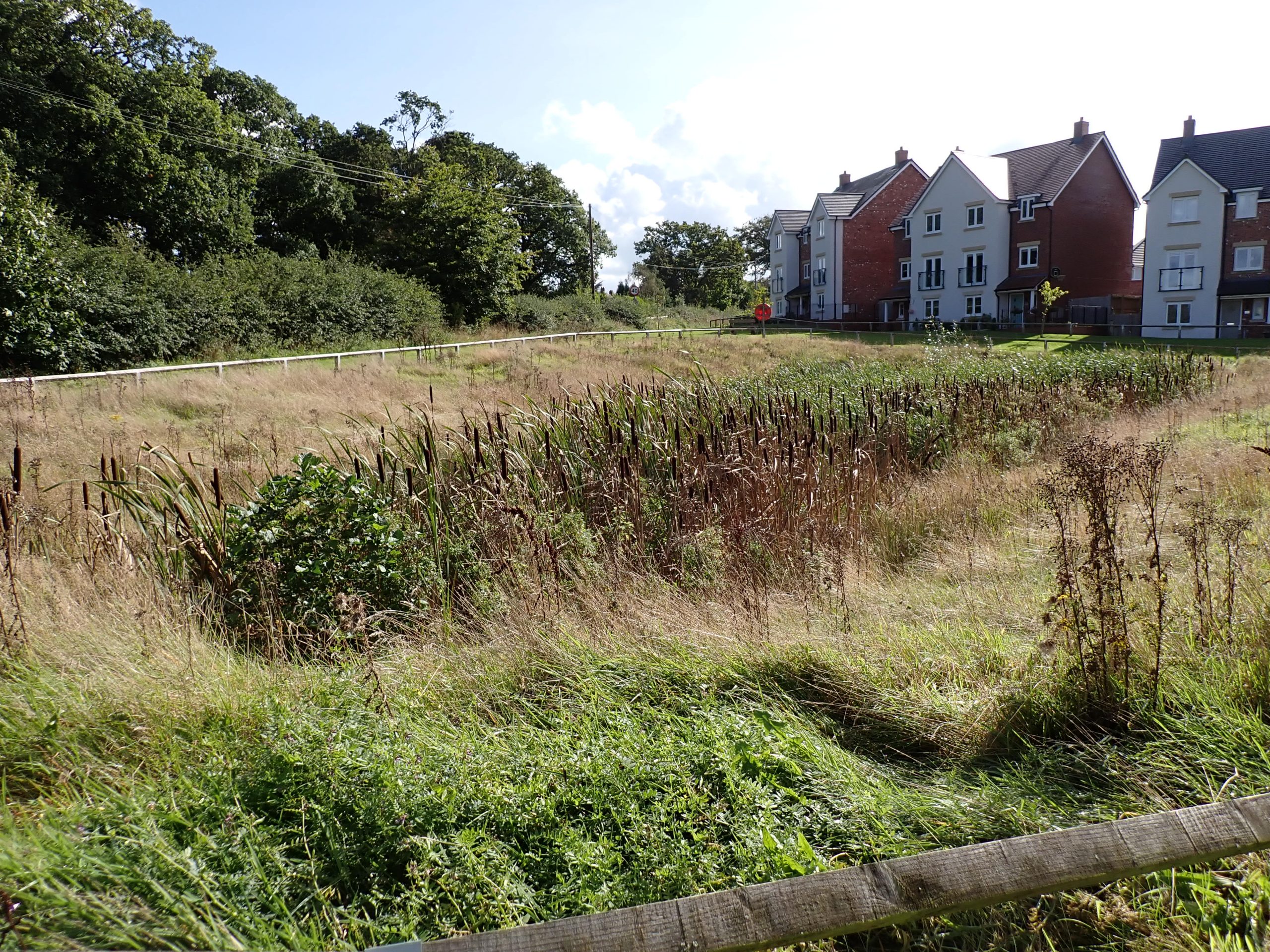
What’s the risk?
For sites where there is a low risk of pollutants being present in surface water runoff, such as small or medium-sized housing developments, a focus on natural SuDS works well. However, where there is a higher risk of the presence pollutants such as sediments, metals, hydrocarbons and nutrients, a more balanced approach to designing SuDS management trains is needed, with an understanding of the expected concentrations of such pollutants and how to deal with them.
The CIRIA SuDS Manual C753 provides a method for dealing with water pollution risks by determining pollution hazard indices for a particular site and then matching SuDS components in the treatment train which have combined pollution mitigation indices equal to or exceeding the pollution hazard indices. The manualprovides pollution hazard indices for a variety of land uses and for three types of pollution: total suspended solids (TSS), metals and hydrocarbons. It also provides mitigation indices for natural SuDS components.
For manufactured components, British Water’s 2022 How To Guide, Applying The CIRIA SuDS Manual (C753) Simple Index Approach To Proprietary/Manufactured Stormwater Treatment Devices, provides a method for calculating mitigation indices for TSS, metals and hydrocarbons.
Note that maintenance considerations are a key part of the design process. All SuDS components, including pretreatment and storage elements, whether natural or manufactured, must be properly maintained so that the system operates as designed. Failure to do so could mean that pollutants are washed on into water bodies and ground water.
More background on these issues can be found in our previous article in the June 2023 issue of Drain Trader.
Low risk Case Study 1: Medium sized residential development
| Pollution hazard level | Low |
| Total suspended solids (TSS) | 0.5 |
| Metals | 0.4 |
| Hydrocarbons | 0.4 |
Table 1: Pollution hazard indices for medium-sized housing development (source: CIRIA C753 Table 26.2)
| Type of SuDS component* | TSS | Metals | Hydrocarbons |
| Swale | 0.5 | 0.6 | 0.6 |
| Permeable pavement | 0.7 | 0.6 | 0.7 |
| Detention basin | 0.5 | 0.5 | 0.6 |
| Bioretention system | 0.8 | 0.8 | 0.8 |
Table 2: Mitigation indices for SuDS components selected (source: CIRIA C753 Table 26.3)
*Remember that after the first SuDS component in the treatment train, only half of the mitigation indices for other downstream components can be used in the calculation.

Consider a new housing development of around 50 homes. According to the CIRIA SuDS Manual, there are likely to be low levels of pollutants in any surface water runoff which means that they can be dealt with using natural SUDS.
Surface water from roads around the development could be collected in swales – shallow drainage channels which run parallel to the roads. These could convey water into a detention basin which would fill up during a heavy rainfall event and then dry out over time, so that pollutants left on the surface are degraded. Run-off from roofs and footpaths would be directed into bioretention zones or rain gardens with engineered media and planting to store and attenuate water.
Residential parking areas may have permeable paving to allow the rainwater to return to the ground where it falls. Permeable concrete block paving is often cited as a permeable paving media, but alternatives include appropriately graded bituminous and concrete pavements, grass reinforcement and bound or unbound gravels.
In areas where planning requirements call for phosphorus neutrality, the treatment train should start by maximising the opportunity for infiltration of stormwater to the ground, since the soil will capture phosphorous in the runoff. A bioretention zone or rain garden would be a good way to achieve this.
Water that cannot be infiltrated may need to pass through a suitable sediment capture component such as a vortex grit separator or oil/water separator (road gullies and catch pits are not recommended) which removes most of the sediment before transferring flow to growing plants that can remove more of the phosphorous. More guidance can be found in CIRIA publication C808 Using SuDS to reduce phosphorous in surface water runoff.
Low risk Case Study 2: School
| Pollution hazard level | Low |
| Total suspended solids (TSS) | 0.5 |
| Metals | 0.4 |
| Hydrocarbons | 0.4 |
Table 3: Pollution hazard indices for school (source: CIRIA C753 Table 26.2)
| Type of SuDS component* | TSS | Metals | Hydrocarbons |
| Swale | 0.5 | 0.6 | 0.6 |
| Permeable pavement | 0.7 | 0.6 | 0.7 |
| Detention basin | 0.5 | 0.5 | 0.6 |
| Bioretention system | 0.8 | 0.8 | 0.8 |
Table 4: Mitigation indices for SuDS components selected (source: CIRIA C753 Table 26.3)
*Remember that after the first SuDS component in the treatment train, only half of the mitigation indices for other downstream components can be used in the calculation.
When designing SuDS for schools, there should be a strong focus on amenity. There is a fantastic opportunity to tell the story of the water cycle to the children who attend the school through the choice of components selected for the SuDS management train.
Water from the roof of the building can be carried in leaping gutters from the edge of the building into a bioremediation zone, which is an area of vegetation with layers of gravel and sand below them, designed to channel and filter surface water. Or the water could run down rain chains into planters, which the children would be able to plant up each year.
As for the housing development, school parking could utilise a permeable pavement. Water from the access road could run off into swales or filter strips. If the water can be managed at the surface, so that the children can see it moving around the site, this can help them to see how precious rainfall is.
For some schools, it may be possible to include a pond or permanent wetland, subject to a risk assessment which should take into account factors such as the ages and abilities of children at the school, whether they can access the water body when unsupervised and the depth of the water. Where they can safely be included, ponds or wetlands in the management train creates habitats for wildlife and provides new learning opportunities.
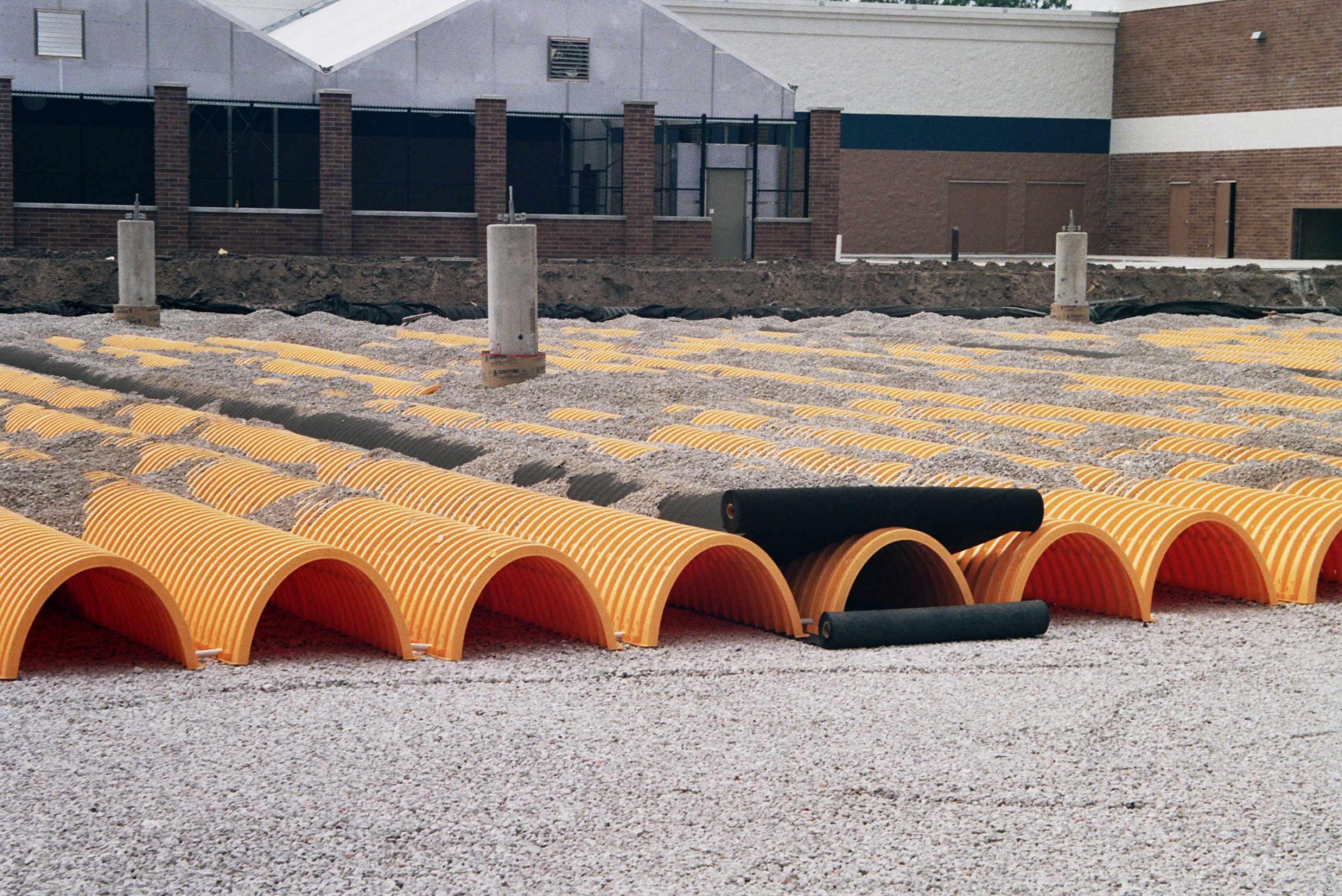
Medium risk Case Study 3: Retail car park
| Pollution hazard level | Medium |
| Total suspended solids (TSS) | 0.7 |
| Metals | 0.6 |
| Hydrocarbons | 0.7 |
Table 5: Pollution hazard indices for retail car park (source: CIRIA C753 Table 26.2)
| Type of SuDS component* | TSS | Metals | Hydrocarbons |
| Vortex separator | 0.8 | 0.5 | 0.7 |
| Detention basin | 0.5 | 0.5 | 0.6 |
Table 6: Mitigation indices for SuDS components selected (source: CIRIA C753 Table 26.3)
For a site where there will be a larger car park, such as a retail development, SuDS management trains must be designed to cope with anthropogenic pollutants in the surface water: tyre wear particles, brake dust and hydrocarbons. Permeable paving may not be appropriate as an infiltration system as the risk of pollutants getting into the groundwater could be too high.
In this imagined development, there is sufficient space around the parking bays for a detention basin which will hold surface water in the case of heavy rainfall events. However, before the water goes to the basin, it must be pre-retreated to remove as much of the sediment as possible, and with it the pollutants that are attached to the sediment particles. A vortex separator, upstream of the basin, could perform this role.
From a biodiversity perspective, note that just because it is possible to create a new habitat doesn’t mean it is the right thing to do. Creating a small green space in a very dense urban area with no connectivity to other green spaces could be detrimental, rather than beneficial, to any wildlife that finds its way there.
Medium risk Case Study 4: Car park, constrained space
| Pollution hazard level | Medium |
| Total suspended solids (TSS) | 0.7 |
| Metals | 0.6 |
| Hydrocarbons | 0.7 |
Table 7: Pollution hazard indices for retail car park (source: CIRIA C753 Table 26.2)
| Type of SuDS component | TSS | Metals | Hydrocarbons |
| StormTech with Isolator Row | 0.8 | 0.6 | 0.7 |
Table 8: Mitigation indices for SuDS components selected (source: British Water Web Site – List of Assessed Surface Water Treatment Devices)
For car parks and other areas with a similar pollution risk, where the space for vegetative SuDS is limited, underground attenuation and treatment could make sense. The constraint on space could be due the limited land availability, which can be the case with smaller brownfield plots, or because losing too many parking spaces would make a development unviable.
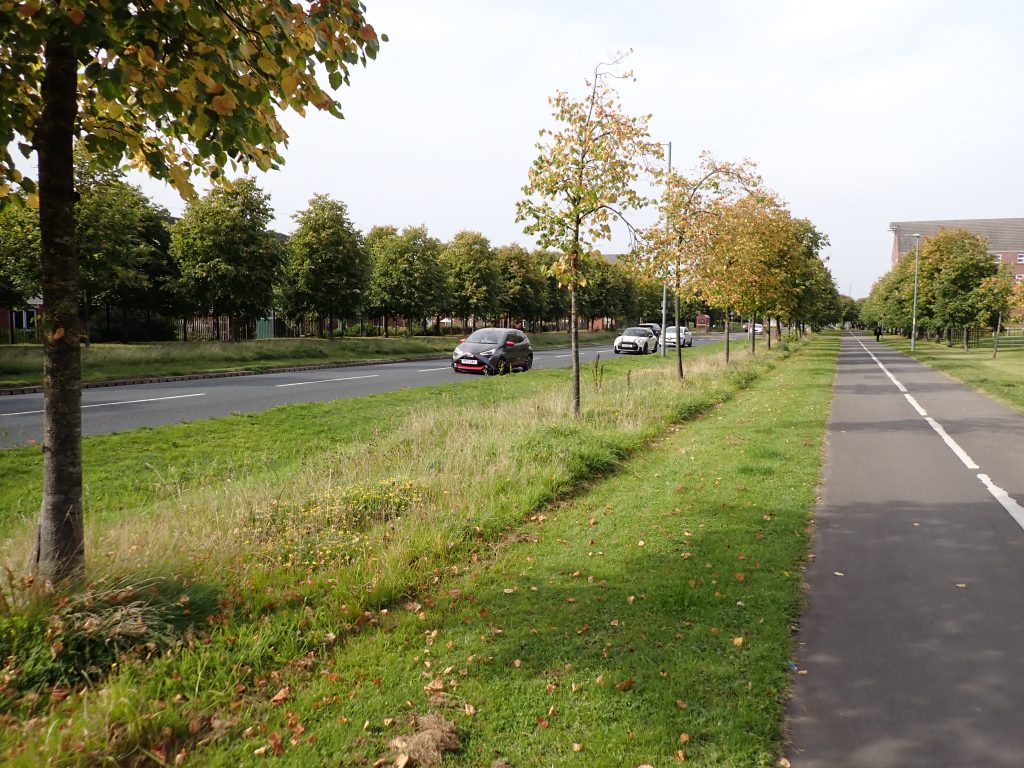
In this situation, below-ground attenuation and treatment devices could work well. While components such as geocellular crates need additional devices upstream of them to remove sediment and other pollutants, there are now systems that have an in-built and easy-to-clean treatment system. In this example, we deploy the StormTech system which includes an Isolator Row to filter out sediment. This can be cleaned out at intervals using standard sewer jetting equipment, accessed via a manhole.
High risk Case Study 5: Motorway,
| Pollution hazard level | High |
| Total suspended solids (TSS) | 0.8 |
| Metals | 0.8 |
| Hydrocarbons | 0.9 |
Table 9: Pollution hazard indices for motorway (source: CIRIA C753 Table 26.2)
| Type of SuDS component* | TSS | Metals | Hydrocarbons |
| Oil/water separator | 0.8 | 0.6 | 0.9 |
| Pond | 0.7 | 0.7 | 0.5 |
Table 10: Mitigation indices for SuDS components selected (sources: SPEL Class 1 Separator product literature; CIRIA C753 Table 26.3)
*Remember that after the first SuDS component in the treatment train, only half of the mitigation indices for other downstream components can be used in the calculation.
Although runoff from many motorways and major trunk roads currently goes straight into water courses without being treated, this should not be an option for new motorways. There is a high risk that there will be heavy amounts of pollutants in the water and that these will do harm to wildlife and plants.
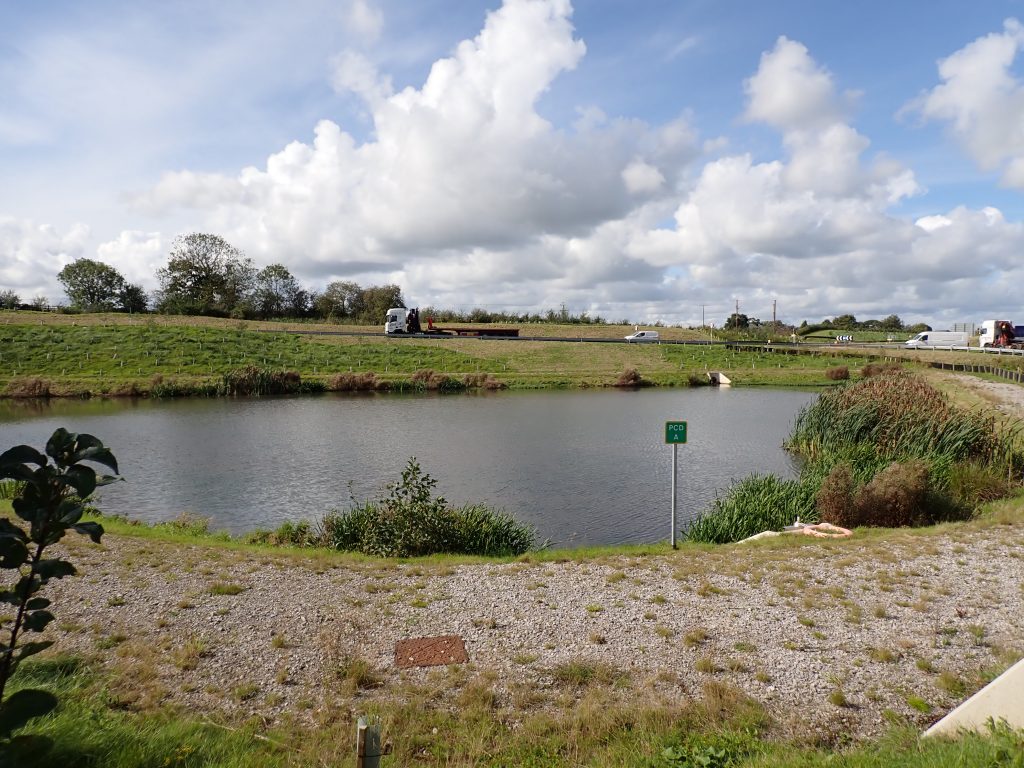
For any application with high pollutant loading and a known presence of harmful runoff that can cause damage to the environment, the water should be treated before entering any vegetative components of a SuDS management train. In this example, we would deploy a properly sized oil/water separator which can take out over 80% of the TSS before it goes into the pond/basin and will capture oil spillages from accidents on the carriageway.
Having been treated to remove the sediment, the water could flow into a pond. Choosing a pond rather than a basin means that more of the residual sediment will settle out because the body of water in the pond slows down the flow more effectively and the sediment rests in one place for longer. However, pollutants clinging to the sediment will remain at the bottom of the pond and may need to be removed periodically.
It is important to get the balance right between pre-treatment in a manufactured device, where the sediment can be easily removed, and treatment in the pond where removal of the sediment is more difficult and expensive. Savings made in capital costs by selecting a smaller separator will soon be overshadowed by the long-term costs of removing sludge from the pond.
.
High risk Case Study 6: waste management site
| Pollution hazard level | High |
| Total suspended solids (TSS) | 0.8 |
| Metals | 0.8 |
| Hydrocarbons | 0.9 |
Table 11: Pollution hazard indices for waste management site (source: CIRIA C753 Table 26.2)
| Type of SuDS component* | TSS | Metals | Hydrocarbons |
| Oil water separator | 0.8 | 0.6 | 0.9 |
| Stormwater filter | 0.8 | 0.6 | 0.7 |
| Retention basin | 0.5 | 0.5 | 0.6 |
| Automatic closure device at outlet from drainage network | |||
Table 12: Mitigation indices for SuDS components selected (sources: SPEL Class 1 Separator product literature,; CIRIA C753 Table 26.3)
*Remember that after the first SuDS component in the treatment train, only half of the mitigation indices for other downstream components can be used in the calculation.
The first step in designing a SuDS management train for a waste management site would be to determine what pollutants would be present on the site and their expected concentrations. These could include metals, hydrocarbons, chemicals and organic compounds.
Once the pollutants have been identified, suitable filters, treatment media or other manufactured devices can be specified. Surface water from any waste processing facility should be treated before it enters any vegetative SuDS features.
For our imagined site, which is processing mixed household waste at a recycling centre, there are risks of leaks and spillages from the oil tank, battery recycling, green waste, discarded paints and household pesticides and more. An oil/water separator will capture oil spillages but spillages of other substances, and pollution from dissolved metals must be captured using additional devices. This could be a special type of stormwater filter, using treatment media to capture the dissolved pollutants.
The SuDS management train should conclude with a vegetative device such as a retention basin where natural processes and micro-organisms can break down any residual pollutants, and the last suspended particles in the runoff can settle on the bottom of the basin. These devices will need to be monitored and maintained, and regular inspections will ensure that any problems are identified and rectified quickly.
Since waste treatment sites can have a high risk of fire, another important water quality issue for waste treatment sites is how the water used to fight a fire would be captured and treated. There needs to be a closure device at the outlet of the site to prevent contaminated water from leaving the area.
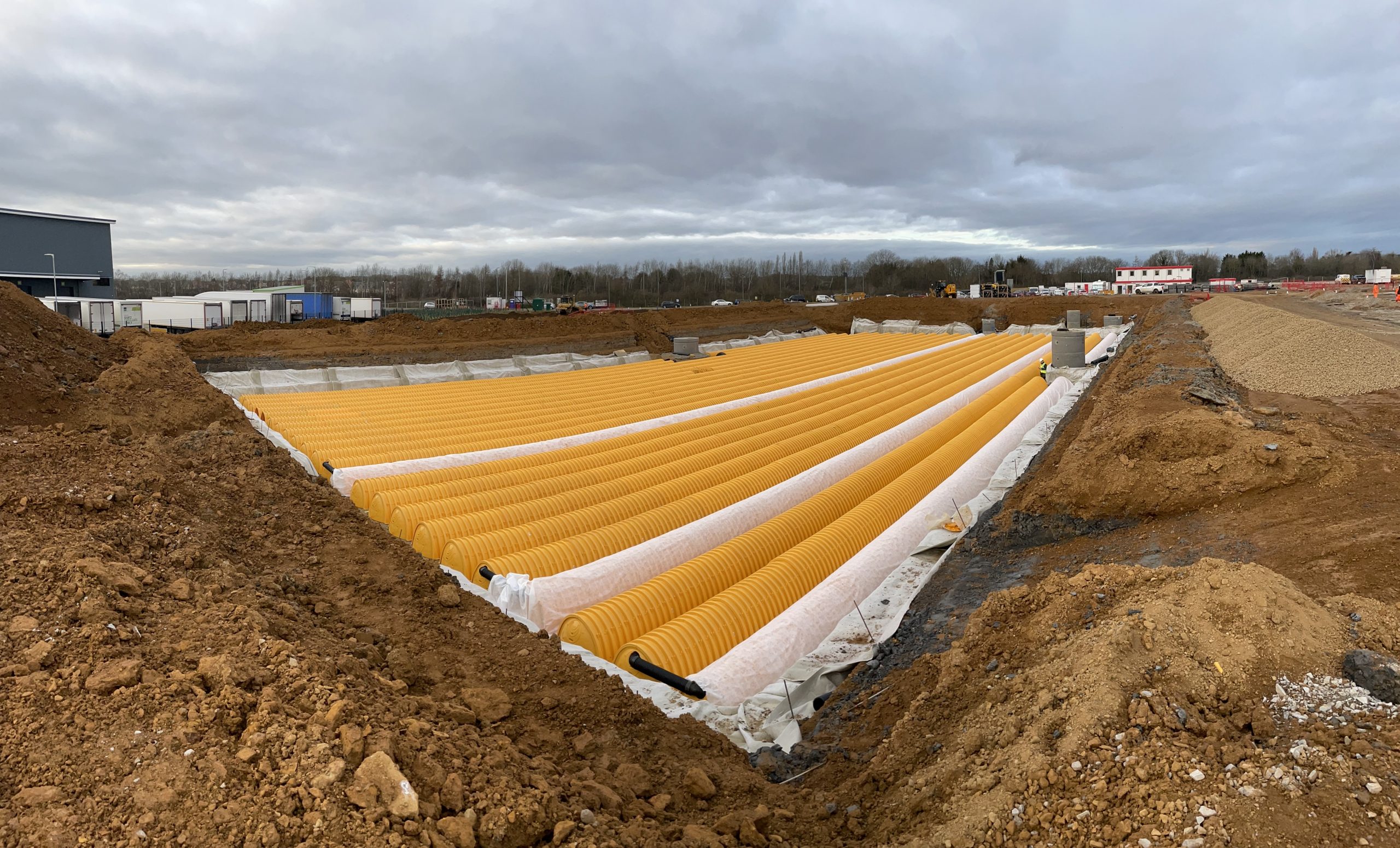
Informed decisions
The design of SuDS management trains is a multi-faceted exercise. Beyond controlling the quantity of water leaving a development, designs must preserve water quality and optimise opportunities to add amenity value and boost biodiversity.
Where the risk of pollutants in surface water runoff is low, the SuDS management train may consist only of natural components. For sites with a medium risk of pollutants, surface water should be treated before it reaches detention features such as ponds, basins or proprietary below-ground systems. Pre-treatment using natural or manufactured components may be possible, depending on circumstances. Surface water from high-risk sites with high pollutant loading should be treated by a suitable manufactured device before it is discharged into vegetative SuDS components.
Differences in the mitigation indices and the sizing of SuDS components to meet the treatment flow rate and the hydraulic (maximum) flow rate also need to be taken into account. Designers also need to have an understanding of the risk of the captured pollutants being flushed out during exceedance events and the pros and cons of the alternative options available.
Design choices should also take maintenance requirements and costs over the lifetime of a development into account, not least because of the need to create asset management strategies and agree commuted sums where SuDS are to be adopted. No system will perform as designed from a water quality or quantity perspective if its components are not properly inspected and maintained. This applies to both vegetative and manufactured elements.
Financial viability is an unavoidable issue. Current regulations regarding SuDS and commercial viability vary in Scotland and Wales. England has yet to decide; a consultation on the implantation of Schedule 3 is expected this year. For restricted brownfield sites, such as the one considered above, it could make sense to allow some room for manoeuvre, depending on the social, economic and environmental impacts of the planned development.
If we are to put together all the pieces of a SuDS jigsaw to the best effect, there must be early conversations between a broader range of stakeholders. Professionals across the supply chain will need to upskill and share knowledge. Some manufacturers of proprietary SuDS systems provide CPD seminars to help SuDS practitioners prepare for the recent changes and those round the corner.
For more information on Advanced Drainage Systems, visit www.adspipe.co.uk.



